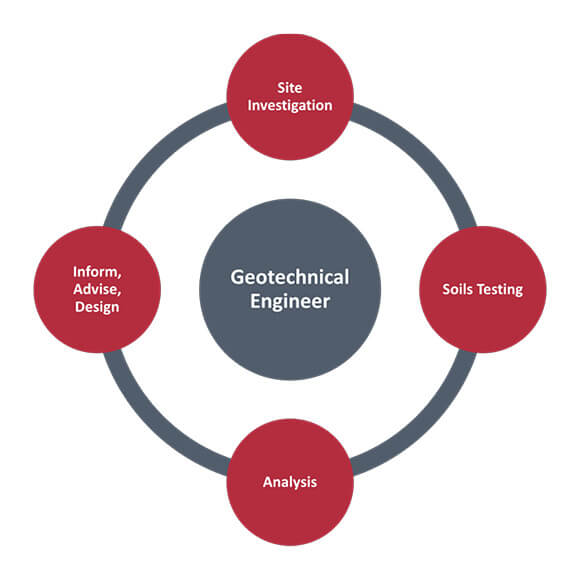The Ultimate Guide To Geotheta
The Ultimate Guide To Geotheta
Blog Article
Excitement About Geotheta
Table of ContentsNot known Details About Geotheta Top Guidelines Of GeothetaGeotheta for DummiesGeotheta Things To Know Before You BuyNot known Details About Geotheta

They carry out website examinations, gather examples, execute laboratory examinations, and evaluate data to review the viability of the ground for building jobs - Geo Tech Engineer. Based upon their findings, geotechnical engineers provide suggestions for structure style, incline stability, maintaining frameworks, and reduction of geotechnical threats. They work together with other professionals, such as designers, architectural engineers, and building and construction groups, to make sure that geotechnical considerations are incorporated right into the total task style and implementation
By examining the actions and properties of dirt and rock, they can identify possible geotechnical risks such as landslides, soil settlement, or incline instability. Their know-how helps prevent failures or crashes that might jeopardize lives and property. Here are some comprehensive tasks and responsibilities of a geotechnical engineer: Website Investigation: Geotechnical designers conduct site examinations to gather information on subsurface conditions.
They translate the information to recognize the residential or commercial properties and actions of the soil and rock, including their toughness, permeability, compaction features, and groundwater problems. Geotechnical Evaluation and Style: Geotechnical designers examine the data gathered throughout site investigations to assess the stability and suitability of the website for building jobs. They execute geotechnical calculations and modeling to review factors such as birthing capability, negotiation, slope stability, side earth stress, and groundwater circulation.
The Best Strategy To Use For Geotheta
Foundation Layout: Geotechnical engineers play a crucial role in making structures that can safely support the intended structure. They examine the dirt problems and tons needs to determine the proper structure kind, such as superficial structures (e.g., grounds), deep structures (e.g (https://www.dreamstime.com/ianhammond2191_info)., stacks), or specialized strategies like soil improvement. They think about variables such as settlement limits, birthing ability, and soil-structure interaction to create ideal structure styles
They evaluate building and construction plans, monitor site activities, and carry out field examinations to verify that the design referrals are adhered to. If unexpected geotechnical issues arise, they analyze the circumstance and offer recommendations for removal or modifications to the layout. Threat Assessment and Reduction: Geotechnical designers analyze geotechnical risks and risks connected with the job website, such as landslides, liquefaction, or soil disintegration.

Partnership and Interaction: Geotechnical designers function closely with other experts associated with a job, such as designers, structural designers, and building groups. Reliable communication and cooperation are necessary to integrate geotechnical considerations right into the total task layout and building and construction procedure. Geotechnical engineers provide technological experience, answer questions, and ensure that geotechnical demands are satisfied.
Not known Facts About Geotheta
Here are some sorts of geotechnical designers: Structure Designer: Structure designers specialize in creating and assessing structures for frameworks. They analyze the soil conditions, lots requirements, and site attributes to figure out the most suitable structure type and style, such as shallow structures, deep structures, or specialized methods like pile foundations.
They assess the elements affecting slope stability, such as dirt homes, groundwater conditions, and slope geometry, and create techniques to prevent incline failures and alleviate risks. Quake Designer: Earthquake engineers focus on examining and creating structures to hold up against seismic pressures. They evaluate the seismic threat of a site, examine dirt liquefaction capacity, and create seismic style criteria to guarantee the safety and security and resilience of structures throughout earthquakes.
They do area screening, gather examples, and analyze the gathered data to characterize the soil buildings, geologic formations, and click now groundwater conditions at a site. Geotechnical Instrumentation Engineer: Geotechnical instrumentation engineers focus on tracking and gauging the habits of dirt, rock, and structures. They mount and keep instrumentation systems that monitor variables such as soil negotiation, groundwater levels, incline movements, and architectural variations to assess performance and give early warnings of potential issues.
Geotheta Can Be Fun For Everyone
They conduct examinations such as triaxial tests, debt consolidation tests, direct shear tests, and permeability tests to collect data for geotechnical evaluation and design. Geosynthetics Designer: Geosynthetics designers focus on the design and application of geosynthetic materials, such as geotextiles, geogrids, and geomembranes. They use these materials to enhance soil stability, reinforce slopes, provide drainage remedies, and control erosion.
They often tend to be investigatory people, which suggests they're intellectual, introspective, and analytical. They are interested, systematic, logical, logical, and logical. A few of them are likewise social, indicating they're kind, charitable, cooperative, client, caring, handy, understanding, sensible, and friendly. Does this seem like you? Take our totally free profession test to figure out if geotechnical engineer is just one of your top career matches.
In the workplace setting, geotechnical engineers use specialized software application tools to execute calculations, develop styles, and assess information. They prepare records, review job requirements, interact with clients and staff member, and coordinate task activities. The office setup gives a conducive setting for research study, evaluation, and collaboration with various other experts included in the job.
Unknown Facts About Geotheta
They regularly go to task websites to perform site investigations, evaluate geotechnical conditions, and gather data for analysis. These visits entail taking a trip to different locations, often in remote or tough surfaces. Geotechnical engineers might execute soil sampling, conduct examinations, and screen building activities to guarantee that the geotechnical aspects of the task are being implemented properly.
Geotechnical engineers also function in specialized geotechnical laboratories. In these facilities, they perform experiments, carry out tests on dirt and rock samples, and examine the engineering buildings of the materials. Geotechnical research laboratory engineers work thoroughly in these environments, handling screening equipment, operating instruments, and recording data. They work together with other laboratory team to ensure precise and dependable screening outcomes.
Report this page